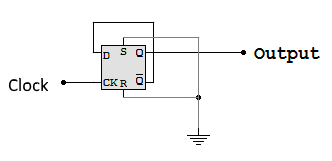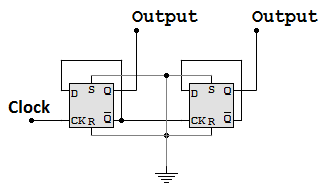
| AS Level Sequential Logic Synchronous Counter >Up Counter and Reset< |
Sequential Logic Up Counter and Reset |
|
On the rising edge of the clock pulse, the input (D) is copied to the output (Q).
Since Q is connected to D, the output is inverted on the rising edge.
A ripple counter is an asynchronous counter where only the first flip-flop is clocked by an external pulse.
All subsequent flip-flops are clocked by the output of the preceding flip-flop.
The counter output might be momentarily wrong until the clock pulse has reached every the flip-flop.
This takes about 20 nanoseconds per flip-flop.
In decimal this counts 0 1 0 1 0 1 and in binary, it's the same.

View counter in the Lushprojects Simulator.
In decimal, this counter counts 0 1 2 3 0 1 2 3 0 1 2 3 and in binary, 00 01 10 11 00 01 10 11 00 01 10 11 00 01 10 11 .

View counter in the Lushprojects Simulator.
This counter goes from zero to five. On reaching six, a microsecond later it has reset to zero. Alter it to count up to nine. The reset should detect ten and cause the reset.
The AND gate is wired to detect six in decimal or in binary, 0 1 1 0. The gate output goes high and the flip flops all reset.
To reset on ten, the binary is 1 0 1 0 but beware! The flip flops are back to front in the diagram so you need 0 1 0 1 with bit values 1 2 4 8.
Subject Name Level Topic Name Question Heading First Name Last Name Class ID User ID
|
Q: qNum of last_q Q ID: Question ID Score: num correct/num attempts Date Done
|
Question Text
image url
Help Link
Add Delete Clone Edit Hardness
Contact, Copyright, Cookies and Legalities: C Neil Bauers - reviseOmatic V4 - © 2016/17
Hosted at linode.com - London
Please report website problems to Neil